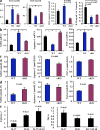Loss of SOCS3 expression in T cells reveals a regulatory role for interleukin-17 in atherosclerosis
- PMID: 19737863
- PMCID: PMC2757872
- DOI: 10.1084/jem.20090545
Loss of SOCS3 expression in T cells reveals a regulatory role for interleukin-17 in atherosclerosis
Abstract
Atherosclerosis is an inflammatory vascular disease responsible for the first cause of mortality worldwide. Recent studies have clearly highlighted the critical role of the immunoinflammatory balance in the modulation of disease development and progression. However, the immunoregulatory pathways that control atherosclerosis remain largely unknown. We show that loss of suppressor of cytokine signaling (SOCS) 3 in T cells increases both interleukin (IL)-17 and IL-10 production, induces an antiinflammatory macrophage phenotype, and leads to unexpected IL-17-dependent reduction in lesion development and vascular inflammation. In vivo administration of IL-17 reduces endothelial vascular cell adhesion molecule-1 expression and vascular T cell infiltration, and significantly limits atherosclerotic lesion development. In contrast, overexpression of SOCS3 in T cells reduces IL-17 and accelerates atherosclerosis. We also show that in human lesions, increased levels of signal transducer and activator of transcription (STAT) 3 phosphorylation and IL-17 are associated with a stable plaque phenotype. These results identify novel SOCS3-controlled IL-17 regulatory pathways in atherosclerosis and may have important implications for the understanding of the increased susceptibility to vascular inflammation in patients with dominant-negative STAT3 mutations and defective Th17 cell differentiation.
Figures






Similar articles
-
Selective regulatory function of Socs3 in the formation of IL-17-secreting T cells.Proc Natl Acad Sci U S A. 2006 May 23;103(21):8137-42. doi: 10.1073/pnas.0600666103. Epub 2006 May 12. Proc Natl Acad Sci U S A. 2006. PMID: 16698929 Free PMC article.
-
Divergent mechanisms utilized by SOCS3 to mediate interleukin-10 inhibition of tumor necrosis factor alpha and nitric oxide production by macrophages.J Biol Chem. 2006 Mar 10;281(10):6316-24. doi: 10.1074/jbc.M508608200. Epub 2005 Dec 12. J Biol Chem. 2006. PMID: 16352613
-
Overexpression of SOCS3 in T lymphocytes leads to impaired interleukin-17 production and severe aortic aneurysm formation in mice--brief report.Arterioscler Thromb Vasc Biol. 2013 Mar;33(3):581-4. doi: 10.1161/ATVBAHA.112.300516. Epub 2013 Jan 17. Arterioscler Thromb Vasc Biol. 2013. PMID: 23329138
-
STAT1 as a novel therapeutical target in pro-atherogenic signal integration of IFNγ, TLR4 and IL-6 in vascular disease.Cytokine Growth Factor Rev. 2011 Aug;22(4):211-9. doi: 10.1016/j.cytogfr.2011.06.003. Epub 2011 Jul 12. Cytokine Growth Factor Rev. 2011. PMID: 21752694 Review.
-
SOCS3 and STAT3, major controllers of the outcome of infection with Mycobacterium tuberculosis.Semin Immunol. 2014 Dec;26(6):518-32. doi: 10.1016/j.smim.2014.10.004. Epub 2014 Nov 1. Semin Immunol. 2014. PMID: 25458989 Review.
Cited by
-
Human monocyte-derived dendritic cells turn into foamy dendritic cells with IL-17A.J Lipid Res. 2015 Jun;56(6):1110-22. doi: 10.1194/jlr.M054874. Epub 2015 Apr 1. J Lipid Res. 2015. PMID: 25833686 Free PMC article.
-
Dendritic Cells and T Cells, Partners in Atherogenesis and the Translating Road Ahead.Front Immunol. 2020 Jul 29;11:1456. doi: 10.3389/fimmu.2020.01456. eCollection 2020. Front Immunol. 2020. PMID: 32849502 Free PMC article. Review.
-
Regulation of ADAMTS-1, -4 and -5 expression in human macrophages: differential regulation by key cytokines implicated in atherosclerosis and novel synergism between TL1A and IL-17.Cytokine. 2013 Oct;64(1):234-42. doi: 10.1016/j.cyto.2013.06.315. Epub 2013 Jul 13. Cytokine. 2013. PMID: 23859810 Free PMC article.
-
The role of the vascular dendritic cell network in atherosclerosis.Am J Physiol Cell Physiol. 2013 Jul 1;305(1):C1-21. doi: 10.1152/ajpcell.00017.2013. Epub 2013 Apr 3. Am J Physiol Cell Physiol. 2013. PMID: 23552284 Free PMC article. Review.
-
Smooth Muscle Cell-Derived Interleukin-17C Plays an Atherogenic Role via the Recruitment of Proinflammatory Interleukin-17A+ T Cells to the Aorta.Arterioscler Thromb Vasc Biol. 2016 Aug;36(8):1496-506. doi: 10.1161/ATVBAHA.116.307892. Epub 2016 Jun 30. Arterioscler Thromb Vasc Biol. 2016. PMID: 27365405 Free PMC article.
References
-
- Ait-Oufella H., Kinugawa K., Zoll J., Simon T., Boddaert J., Heeneman S., Blanc-Brude O., Barateau V., Potteaux S., Merval R., et al. 2007. Lactadherin defciency leads to apoptotic cell accumulation and accelerated atherosclerosis in mice.Circulation. 115:2168–2177 doi:10.1161/CIRCULATIONAHA.106.662080 - DOI - PubMed
-
- Bettelli E., Oukka M., Kuchroo V.K. 2007. T(H)-17 cells in the circle of immunity and autoimmunity.Nat. Immunol. 8:345–350 doi:10.1038/ni0407-345 - DOI - PubMed
-
- Binder C.J., Chang M.K., Shaw P.X., Miller Y.I., Hartvigsen K., Dewan A., Witztum J.L. 2002. Innate and acquired immunity in atherogenesis.Nat. Med. 8:1218–1226 doi:10.1038/nm1102-1218 - DOI - PubMed
-
- Boddaert J., Mallat Z., Fornes P., Esposito B., Lecomte D., Verny M., Tedgui A., Belmin J. 2005. Age and gender effects on apoptosis in the human coronary arterial wall.Mech. Ageing Dev. 126:678–684 doi:10.1016/j.mad.2005.01.001 - DOI - PubMed
-
- Chen Z., Laurence A., Kanno Y., Pacher-Zavisin M., Zhu B.M., Tato C., Yoshimura A., Hennighausen L., O'Shea J.J. 2006. Selective regulatory function of Socs3 in the formation of IL-17-secreting T cells.Proc. Natl. Acad. Sci. USA. 103:8137–8142 doi:10.1073/pnas.0600666103 - DOI - PMC - PubMed
Publication types
MeSH terms
Substances
LinkOut - more resources
Full Text Sources
Other Literature Sources
Medical
Molecular Biology Databases
Miscellaneous

